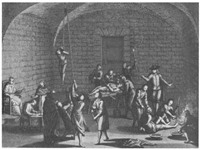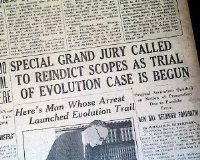THE THEOLOGICAL ENGINEER
Faithless Fairy Tales
Introduction
By Jeff Laird


Single Page/Printer Friendly
Continued from Page One

THE SPANISH INQUISITION
The Myth: Once upon a time, the Catholic Church formed an army of Inquisitors, who tortured and imprisoned vast numbers of people, forcing them to convert or die. Those who refused were either hung, or burned at the stake. Thousands of women were executed as witches, and the population lived in terror of the Inquisition. Untold thousands were killed.The Truth: The Spanish Inquisition was requested, administrated, and implemented by the secular government of Spain, essentially borrowing Church resources. Over several centuries, it developed into a more clandestine effort, but remained primarily under secular direction. The motivation was social order; the primary targets were those professing beliefs which undermined established social structures. Over its approximately 400-year duration, the Inquisition is estimated to have executed about 100 suspected witches, and between 3-5,000 people in total.
The actual procedure for the Inquisition involved a sort of travelling court, which would spend nearly a month encouraging orthodoxy in a town. Those who rejected their ideas were excommunicated. Convicted heretics were typically assigned penance. It was common for local communities to deride the Inquisitors' sentences as too lenient, and drag the accused out of prisons to enact mob justice. Inquisitors used torture far less often than did purely secular courts. The populace was certainly sour on the Inquisition, but out of cynicism rather than fear. Many recognized the system as ripe for false accusations and land grabs.
Of course, even one instance of torture, or even one death, is too many. But the graphic depictions, staggering death tolls, and culture of terror invoked by pop culture are all historically false.
THE CRUSADES

The Truth: The early Crusades were all in response to Muslim aggression, both against Christian pilgrims and European territories. Islamic armies had aggressively pushed into Spain, the Mediterranean islands, and through most of the Middle East. The combination of rapid Muslim expansion, standing armies in Europe, and religious persecution of travelling Christians combined to spark the first Crusade. The first three Crusades were all in response to Islamic aggression.
Subsequent Crusades were more and more politicized, and popular opinion flagged as a result. These wars were also not particularly brutal or unusual, from a cultural standpoint. Islamic and Christian armies alike fought with the brutality common to all wars of that day and age. From the very beginning, voices within Christianity objected to the blending of religion and warfare. In fact, the expansion of Papal power and the use of questionable theology seen during the Crusades was a major factor in bringing about the Reformation. Interestingly, Islamic historians thought very little of the Crusades until fairly recently.
In short, religion was a tool used by Crusaders, and a rallying theme of the Crusades, but it was certainly not the ultimate motivation or cause of the Crusades. They can't be justified from a Biblical standpoint, but neither can they be painted as especially heinous, nor blamed on the Bible.
THE SCOPES MONKEY TRIAL

The Truth: Scopes was a physical education teacher who occasionally filled in for the science class. He would later admit he never actually taught evolution to anyone. Scopes volunteered to be prosecuted in response to a group of anti-religious businessmen, who concocted the trial as a test case-slash-publicity stunt. Scopes never saw the inside of a cell. The judge ordered all scientific evidence to be archived, since the actual trial had nothing to do with evolution, but whether Scopes had violated the Butler Act, which forbade teaching evolution in public schools and was later repealed.
Lead defense attorney Clarence Darrow took the case specifically so he could confront prosecutor William Jennings Bryan over religion. Darrow's cross-examination of Bryan was only a surprise to Bryan — Darrow held practice sessions with his legal team preparing his attack. On the stand, Bryan readily admitted that Genesis might not mean literal 24-hour days, and transcripts show he actually got the better of Darrow, who came across as petty. Bryan also noted that he'd read The Origin of Species, a book Darrow admitted he had given up on reading after 50 pages.
Bryan had only agreed to be examined as an expert on the Bible if he could put Darrow on the stand to answer for Darwinism, but after two hours of Darrow's questions, the judge ordered the entire exchange inadmissible. Darrow then asked the jury to find his client guilty, and waived his closing remarks specifically so Bryan would not be able to speak again. Scopes was fined $100, later overturned on the grounds that he could only have been fined $50. Bryan died a few days later in his sleep, having been in poor health for some time.
Most of what people think they know about The Scopes Trial actually comes from stage and film versions of Inherit the Wind, which was loosely based on the actual events. In fact, few people remembered or thought much of the Scopes Trial in the 30 years between the verdict and the play's debut.
These pseudo-historical myths do more than confuse, they deceive. Re-imagining the past to suit an anti-religious agenda may well suit the preferences of some, but it simply does not hold up to historical scrutiny. Those who base their opinions of religion on fairy tales need a healthy dose of reality to break the spell. In the future, I'll take individual looks at these anti-religious myths, and the historical realities behind them.

Introduction
Part 1: Galileo
Part 2: The Scopes Trial
Part 3: The Crusades
Part 4: The Spanish Inquisition
Image 3: Inquisition torture chamber, 1716; Public Domain
Image 4: Battle between Hussite warriors and Crusaders, Jena Codex, 15th Century; Public Domain
Image 5: the Omaha Evening Bee, Nebraska, July 10, 1925
Tags: | Biblical-Truth | Controversial-Issues | False-Teaching | History-Apologetics | Political-Issues
comments powered by Disqus
Published 5-28-2014

